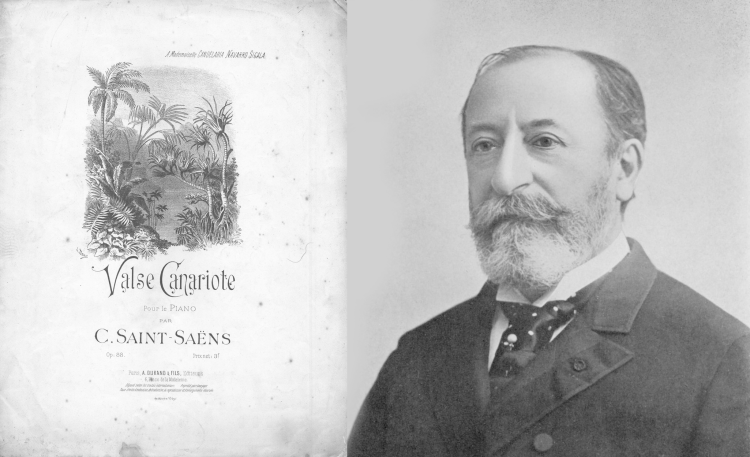- El universal compositor y músico francés llegó de incógnito a la ciudad, en donde dejó su poso como un apasionado actor cultural implicado en la sociedad del momento
El compositor francés Camille Saint-Saëns (París, 1835-Argel, 1921) es Hijo Adoptivo de Las Palmas de Gran Canaria. Una distinción que la ciudad le concedió en el año 1900, cuando, además, se bautizó con su nombre uno de los salones del Teatro Tirso De Molina. Hoy, el mismo recinto, rebautizado desde principios del Siglo XX como Teatro Pérez Galdós, sigue conservando esa denominación: el emblemático salón, además, está adornado con unosfrescos del artista modernista canario Néstor Martín-Fernández de la Torre. En el exterior del teatro la figura del músico universal permanece relajada, disfrutando del centro urbano clásico de la capital grancanaria: así lo inmortalizó, en cantería de Arucas, el escultor grancanario Juan Borges Linares en 1987. Qué curiosa, la presencia de Saint-Saëns, el gran renovador de la música francesa, en un enclave como la desembocadura del barranco Guiniguada.
Tiene su explicación. Esto es, una historia peculiar que trajo al virtuoso pianista, compositor y director de orquesta parisino a la isla de Gran Canaria y a su capital. Un relato que también retrata la escena cultural y la sociedad del momento en la ciudad, que tuvo siempre una vocación de permanecer conectada a las vanguardias culturales del continente. Especialmente, en este periodo de la historia. Camille Saint-Saëns, en efecto, mantuvo una relación particular con Las Palmas de Gran Canaria, en una isla en la que reincidió en varias estancias, fechadas entre 1889 y 1909. ¿Qué hacía un francés notable en la isla, en una época en la que la presencia británica era predominante? ¿Y por qué se acabaría ganando el favor y el cariño de los ciudadanos de la capital grancanaria?
Las fuentes históricas hablan de siete visitas documentadas del compositor, en principio, "por motivos de salud", castigada por la fragilidad de sus pulmones. Lejos del frío de París, llegó a Gran Canaria de incógnito. Por eso no llamó la atención que el supuesto comerciante francés, melómano y apasionado de las artes Charles Sannois llegara desde Francia. Menos, cuando se refugió en la Villa Melpómene, en el municipio de Santa María de Guía, en la casa de su amigo, y cónsul de Francia, Jean Ladevèze y Redonet. Pero las pasiones intelectuales de aquel desinquieto burgués parisino le llevaron pronto a frecuentar los foros culturales de Las Palmas de Gran Canaria. Su propia naturaleza le empujó a dejarse ver, y a participar con locuacidad, en las tertulias que regularmente acogía el Gabinete Literario de Las Palmas. Los contertulios pronto quedaron deslumbrados por sus amplios conocimientos y capacidades musicales. El tal Sannois también se atrevió a acudir a los ensayos de la temporada de ópera en el Teatro Tirso De Molina. Músico natural, hasta le discutió al maestro Bernardino Valle su conducción de la orquesta en una muy señalada ocasión en la que el francés terminó abandonando el recinto, frustrado. De un talento rebosante, el compositor no parecía especialmente hábil a la hora de mantener el secreto de su identidad. Sobre todo, cuando su ausencia de los foros parisinos había levantado todo tipo de especulaciones e inquietudes acerca de su paradero, o incluso su estado. Fue tal el eco de su desaparición que las fotografías de su rostro, que reproducían los diarios franceses del momento, acabaron llegando a la prensa local grancanaria. Y fue, finalmente, en el antiguo Teatro Cairasco, también sede de la sociedad del Gabinete Literario, cuando se le reconoció como el genuino Camille Saint-Saëns.
A partir de ese momento el cariño ciudadano hacia su figura y su persona no hizo más que crecer en la capital grancanaria. También por la implicación que el músico francés demostró con la Sociedad Filarmónica de Gran Canaria (la primera sociedad de su género en España, fundada en 1845, junto a su Orquesta Filarmónica de Gran Canaria). Acabó siendo designado como Socio de Mérito y Presidente Honorario de esta entidad, a la que dirigió en diferentes ocasiones. A menudo, con fines altruistas.
Saint-Saëns también firmó dos composiciones dedicadas a Gran Canaria, Valse canariote pour le piano. Op. 88 y Campanas de Las Palmas, estrenadas en la capital grancanaria. Aún hoy, su figura y aquella presencia suya en la ciudad siguen siendo motivo de homenajes, celebraciones y recuerdo. Algo a lo que también contribuye una calle del barrio inglés de Ciudad Jardín que, al igual que otra vía en el municipio de Santa María de Guía, también lleva su nombre. Eso sí, su nombre 'canario': Camilo Saint Saenz.




